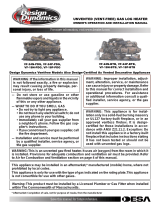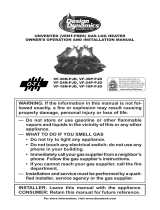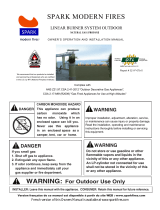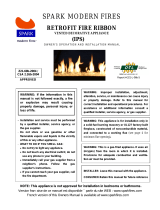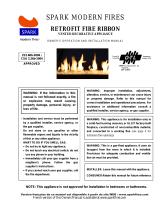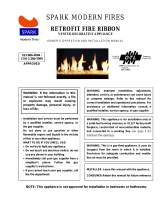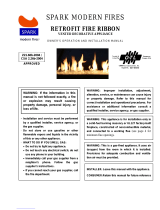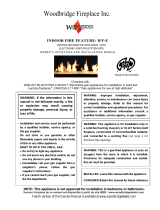
111826-02F
For more information, visit www.desatech.com
2
SAFETY INFORMATION
Carbon Monoxide Poisoning: Early signs of carbon mon ox ide
poisoning re sem ble the fl u, with head aches, dizziness, or nau sea.
If you have these signs, the log set may not be working properly.
Get fresh air at once! Have log set serviced. Some people are more
affected by carbon monoxide than others. These include preg nant
wom en, peo ple with heart or lung disease or ane mia, those under
the in fl u ence of alcohol, and those at high altitudes.
Natural & LP Gas : Natural & LP gas are odorless. An odor-mak-
ing agent is added to the gas. The odor helps you detect a gas leak.
However, the odor added to the gas can fade. Gas may be present
even though no odor exists.
Make certain you read and understand all warnings. Keep this
manual for reference. It is your guide to safe and proper operation
of this log set.
WARNING ICON G 001
WARNINGS
IMPORTANT: Read this owner’s man u al carefully and
completely be fore trying to assemble, op er ate, or ser-
vice this log set. Im prop er use of this log set can cause
se ri ous injury or death from burns, fi re, ex plo sion, elec-
trical shock, and carbon mon ox ide poi son ing.
DANGER: Carbon mon ox ide poisoning may lead
to death!
WARNING: Any change to this log set or its con-
trols can be dan ger ous.
WARNING: Keep fl ue open when operating unit.
TABLE OF CONTENTS
SAFETY INFORMATION
1. This appliance, as supplied, is only for use with the type of gas
indicated on the rating plate.
2. If you smell gas
• shut off gas supply
TABLE OF CONTENTS
SAFETY INFORMATION..............................................................2
LOCAL CODES............................................................................3
PRODUCT IDENTIFICATION.......................................................3
UNPACKING.................................................................................4
PRODUCT FEATURE ..................................................................4
INSTALLATION ............................................................................7
OPERATING AP PLI ANCE..........................................................11
INSPECTING BURNERS ..........................................................13
CLEANING AND MAINTENANCE .............................................13
TROUBLESHOOTING................................................................14
REPLACEMENT PARTS............................................................18
ILLUSTRATED PARTS BREAKDOWN AND PARTS LIST.........20
ACCESSORIES..........................................................................22
OWNER'S REGISTRATION FORM............................................23
WARRANTY INFORMATION ...................................... Back Cover
• do not try to light any appliance
• do not touch any elec tri cal switch; do not use any phone in
your build ing
• immediately call your gas supplier from a neighbor’s phone.
Follow the gas supplier’s instructions
• if you cannot reach your gas sup plier, call the fi re de part ment
3. Never install the log set
• in a recreational vehicle
• where curtains, furniture, clothing, or other fl ammable ob-
jects are less than 42 inches from the front, top, or sides of
the log set
• in high traffi c areas
• in windy or drafty areas
4. Before installing in a solid fuel burn ing fi replace, the chim ney
fl ue and fi re box must be cleaned of soot, creosote, ash es and
loose paint by a qualifi ed chimney cleaner. Creosote will ig nite
if highly heated. Inspect chimney fl ue for damage. If dam aged,
repair fl ue before operating appliance.
5. You must operate this log set with fi replace doors or screens in
place and fully closed. Unless provided by other means, screens
shall have openings for in tro duc tion of combustion air.
6. This log set is designed to be smoke less. If logs ever appear to
smoke, turn off appliance and call a qual i fi ed ser vice per son.
Note: During ini tial op er a tion, slight smok ing could oc cur due
to log curing and the burning of man u fac tur ing res i dues. You
may wish to add more ventilation by opening a win dow.
7. To reduce the creation of soot, follow the in struc tions in Clean-
ing and Main te nance, page 13.
8. Do not allow fans to blow directly into the fi replace. Avoid any
drafts that al ter burner fl ame patterns. Ceiling fans can create
drafts that alter burner fl ame patterns. Altered burner patterns
can increase sooting.
9. Do not use a blower insert, heat ex chang er insert or other ac-
ces so ry not approved for use with this log set.
10. The installation and provisions for combustion and ventilation air
must conform with the National Fuel Gas Codes, ANSI Z233.1/
NFPA 54, Section 5.3, Air for Combustion and Ven ti la tion.
11. Do not run log set
• where fl ammable liquids or vapors are used or stored
• under dusty conditions
WARNING: This product contains and/or generates
chemicals known to the State of California to cause
cancer or birth defects, or other reproductive harm.




















